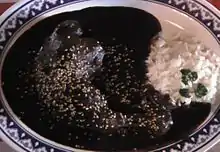Barbacoa
Barbacoa (Spanish: [baɾβaˈkoa] (![]() listen)) is a form of cooking meat that originated in the Arawak-speaking Caribbean with the Taíno people, from which the term "barbecue" derives.[1] In contemporary Mexico, it generally refers to meats or whole sheep or whole goats slow-cooked over an open fire or, more traditionally, in a hole dug in the ground covered with agave (maguey) leaves, although the interpretation is loose, and in the present day (and in some cases) may refer to meat steamed until tender. This meat is known for its high fat content and strong flavor, often accompanied with onions and cilantro (coriander leaf).
listen)) is a form of cooking meat that originated in the Arawak-speaking Caribbean with the Taíno people, from which the term "barbecue" derives.[1] In contemporary Mexico, it generally refers to meats or whole sheep or whole goats slow-cooked over an open fire or, more traditionally, in a hole dug in the ground covered with agave (maguey) leaves, although the interpretation is loose, and in the present day (and in some cases) may refer to meat steamed until tender. This meat is known for its high fat content and strong flavor, often accompanied with onions and cilantro (coriander leaf).
.JPG.webp)
Adaptations

In the U.S., barbacoa is often prepared with parts from the heads of cattle, such as the cheeks. In northern Mexico, it is also sometimes made from beef head, but more often it is prepared from goat meat (cabrito). In central Mexico, the meat of choice is lamb, and in the Yucatan, their traditional version, cochinita pibil (pit-style pork), is prepared with pork.
Barbacoa was later adopted into the cuisine of the southwestern United States by way of Texas. The word transformed in time to "barbecue",[2] as well as many other words related to ranching and Tex-Mex cowboy or vaquero life. Considered a specialty meat, barbacoa is typically sold on weekends or holidays in certain parts of Texas and in all of Mexico. Barbacoa is also popular in Florida, as many Mexican immigrants living there have introduced this dish. Barbacoa is also well known in Honduras.
In the Philippines, the Visayan dish balbacua (also spelled balbakwa) is named after barbacoa, probably for the similar length of cooking time and tenderness of the meat. It is a completely different dish. Unlike Latin American versions, it is a stew made from beef, oxtail, cow feet and skin boiled for several hours until gelatinous and extremely tender.[3][4]
Traditions
A traditional Mexican way of eating barbacoa is having it served on warm corn tortillas with salsa verde (green salsa) for added flavor; the tacos are often eaten with diced onions, chopped cilantro .
To be specific barbacoa, in the region of Oaxaca, Mexico, is sometimes accompanied by a traditional dish called "yiki". Yiki is a stew made of diced corn with chilis and water. It often includes avocado leaves, salt, and other spices that could only be identified in Oaxaca. The process to make this stew starts a night before it is served. This is to get the maíz softened and it takes off the thin layer of shell type in order for it to be edible in the stew. Once the stew is served, it is distinctive looking and tasting. As a topping, sometimes cooked goat liver is added to the stew.
Etymology

The word barbacoa is believed to have come from the mainland Taino (eastern Dominican Republic), as in this source:
Pero tomemos el vocablo barbacoa, cuyo origen arau[a]co (específicamente, taíno) es conocido gracias a las descripciones de Gonzalo Fernández de Oviedo en su Historia natural y general de las Indias, quien testimonia dos de sus acepciones.[5]
But when we take the term 'barbacoa', which originates from Arawak (specifically, the Taíno language), it is known thanks to the writings of Gonzalo Fernández de Oviedo in his Natural and General History of the Indians, who described two of its meanings: «unos palos que ponen, a manera de parrilla o trébedes, en hueco», para asar los peces y animales que cazaban. Tal aseveración compite con la tesis de que, al designar un tipo de parrillada, esa palabra es una castellanización de la palabra inglesa-norteamericana barbecue, que a su vez nace de la expresión francesa de la barbe á la queue («de la barba ¾o mentón¾ a la cola», que era como los tramperos canadienses francófonos ensartaban con una barra de hierro las reses que cazaban para asarlas.
References
- The Great American Barbecue and Grilling Manual by Smoky Hale. Abacus Publishing, 2000. ISBN 0-936171-03-0
- "Barbecue | Define Barbecue at Dictionary.com". Dictionary.reference.com. Archived from the original on 8 April 2010. Retrieved 2010-04-04.
- "Balbacua". Panlasang Pinoy. Retrieved 2 August 2015.
- "Lanciao & Balbacua". Market Manila. Retrieved 2 August 2015.
- "IV CILE. Paneles y ponencias. Eusebio Leal Spengler". Congresosdelalengua.es. Archived from the original on 11 April 2010. Retrieved 2010-04-04.





.jpg.webp)




_01.JPG.webp)